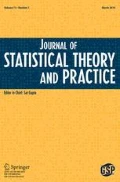Abstract
Optimal design for the joint estimation of the mean and covariance matrix of the random effects in hierarchical linear models is discussed. A criterion is derived under a Bayesian formulation which requires the integration over the prior distribution of the covariance matrix of the random effects. A theoretical optimal design structure is obtained for the situation where the random effects have equal variances and zero covariances. For other situations, optimal designs are obtained through computer search. It is shown that orthogonal designs, if they exist, are optimal under a main effects model with independent random effects. When the random effects are believed to be correlated, it is shown by example that nonorthogonal designs tend to be more efficient than orthogonal designs. In addition, design robustness is studied under various prior mean specifications of the random effects covariance matrix.
Similar content being viewed by others
References
Allenby, G. M. and Lenk, P. J., 1994. Modeling household purchase behavior with logistic normal regression, Journal of American Statistical Association 89, 1218–1229.
Arora, N. and Huber, J., 2001. Improving parameter estimates and model prediction by aggregate customization in choice experiments, Journal of Consumer Research 28, 273–283.
Berger, J. O., 1985. Statistical Decision Theory and Bayesian Analysis, Springer Verlag, New York.
Bradlow, E. T. and Rao, V. R., 2000. A hierarchical Bayes model for assortment choice, Journal of Marketing Research 37, 259–268.
Chaloner, K. and Verdinelli, I., 1995. Bayesian experimental design, A review, Statistical Science 10, 273–304.
Draper, D., 1995. Inference and hierarchical modeling in the social sciences, Journal of Educational and Behavioral Statistics 20, 115–147.
Entholzner, M., Benda, N., Schmelter, T. and Schwabe, R., 2005. A note on designs for estimating population parameters, Biometrical Letters — Listy Biometryczne, 25–41.
Fedorov, V. V. and Hackl, P., 1997. Model-oriented Design of Experiments, Springer Verlag, New York.
Giovagnoli, A. and Sebastiani, P., 1989. Experimental designs for mean and variance estimation in variance components models, Computational Statistics and Data Analysis 8, 21–28.
Goldstein, H., 2003. Multilevel Statistical Models, Third Edition, Hodder Arnold, London.
Graybill, F. A., 1983. Matrices with Applications in Statistics, Wadsworth, Belmont, CA.
Han, C. and Chaloner, K., 2004. Bayesian experimental design for nonlinear mixed-effects models with applications to HIV dynamics, Biometrics 60, 25–33.
Kessels, R., Goos, P. and Vandebroek, M., 2006. A comparison of criteria to design efficient choice experiments, Journal of Marketing Research 43, 409–419.
Lenk, P. J., Desarbo, W. S., Green, P. E. and Young, M. R., 1996. Hierarchical Bayes conjoint analysis, Recovery of partworth heterogeneity from reduced experimental designs, Marketing Science 15, 173–191.
Liu, Q., Dean, A. M. and Allenby, G. M., 2007. Optimal experimental designs for hyperparameter estimation in hierarchical linear models, https://doi.org/www.stat.osu.edu/~amd/dissertations.html, Submitted for publication.
Magnus, J. R. and Neudecker, H., 1999. Matrix Differential Calculus with Applications in Statistics and Econometrics, John Wiley, New York.
Mentré, F., Mallet, A. and Baccar, D., 1997. Optimal design in random-effects regression models, Biometrika 84, 429–442.
Montgomery, A. L., Li, S., Srinivasan, K. and Liechty, J. C., 2004. Modeling online browsing and path analysis using clickstream data, Marketing Science 23, 579–595.
Morrison, D. F., 1990. Multivariate Statistical Methods, McGraw-Hill, Inc., New York.
Pukelsheim, F., 1993. Optimal Design of Experiments, John Wiley, New York.
Raudenbush, S. W., 1993. A crossed random effects model for unbalanced data with applications in crosssectional and longitudinal research, Journal of Educational Statistics 18, 321–349.
Raudenbush, S. W. and Bryk, A. S., 2002. Hierarchical Linear Models,Applications and Data Analysis Methods, Sage Publications, Thousand Oaks, CA.
Rossi, P. E., Allenby, G. M. and McCulloch, R., 2005. Bayesian Statistics and Marketing, John Wiley, Hoboken, NJ.
S—ndor, Z. and Wedel, M., 2001. Designing conjoint choice experiments using managers— prior beliefs, Journal of Marketing Research 38, 430–444.
S—ndor, Z. and Wedel, M., 2002. Profile construction in experimental choice designs for mixed logit models, Marketing Science 21, 455–475.
S—ndor, Z. and Wedel, M., 2005. Differentiated Bayesian conjoint choice designs, Journal of Marketing Research 55, 210–218.
Scheffé, H., 1959. The Analysis of Variance, John Wiley, New York.
Silvey, S. D., 1980. Optimal Design, Chapman and Hall, London.
Smith, A. and Verdinelli, I., 1980. A note on Bayesian designs for inference using a hierarchical linear model, Biometrika 67, 613–619.
Tod, M., Mentré, F., Merlé, Y. and Mallet, A., 1998. Robust optimal design for the estimation of hyperparameters in population pharmacokinetics, Journal of Pharmacokinetics and Biopharmaceutics 26, 689–716.
Yuh, L., Beal, S., Davidian, M., Harrison, F., Hester, A., Kowalski, K., Vonesh, E. and Wolfinger, R., 1994. Population pharmacokinetics/pharmacodynamics methodology and applications, A bibliography, Biometrics 50, 566–575.
Author information
Authors and Affiliations
Corresponding author
Rights and permissions
About this article
Cite this article
Liu, Q., Dean, A.M. & Allenby, G.M. Design for Hyperparameter Estimation in Linear Models. J Stat Theory Pract 1, 311–328 (2007). https://doi.org/10.1080/15598608.2007.10411843
Received:
Revised:
Published:
Issue Date:
DOI: https://doi.org/10.1080/15598608.2007.10411843




